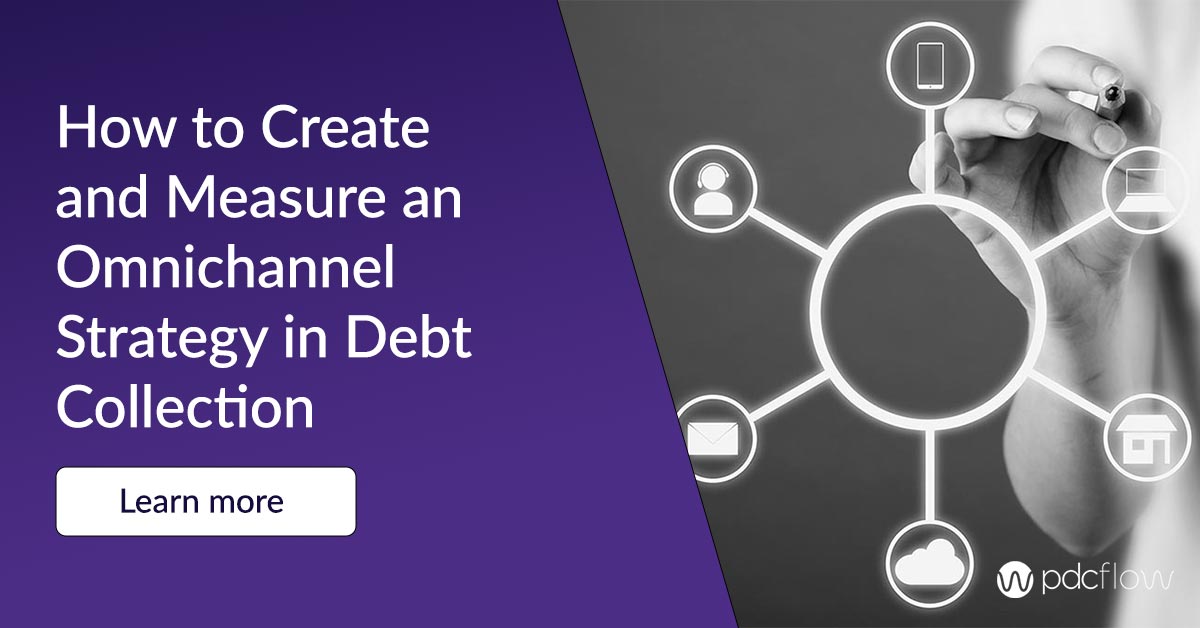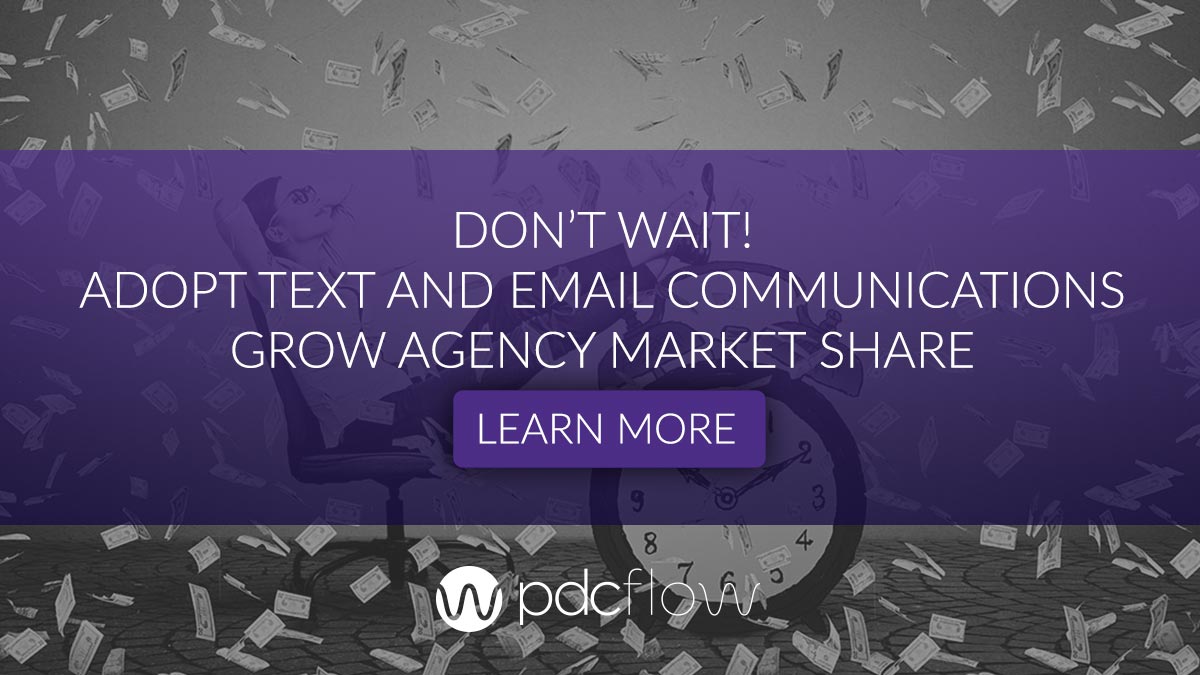In a recent PDCflow sponsored webinar on accountsrecovery.com, a panel of digital collection experts sat down to discuss the differences they’ve encountered in text messaging and email for debt collection.
Shawn Farris, Brandy Rouselle, and Chris Repholz discussed which channels they each prefer and the strengths of each. They also covered how using SMS messages together with email for debt collection in a single strategy boosts engagement and builds trust.
Choosing One: Text or Email for Debt Collection?
Which channel is best for reaching consumers about their debt? The answer may change depending on your agency’s structure, the type of debt you collect and the information and opt-ins you have for consumers.
Both Farris and Rouselle agree that a collection email is their preferred form of communication for digital engagement.

“I would start with an email. It allows you to say more,” says Farris. He also likes using email as a way to drive consumers to take further action on your messages:
- How to visit your self service portal
- The payment options available
- How to contact an agent

Although she likes using both, Rouselle also would choose using email over text if she had to choose just one option.
“You can send a lot more information, you can maintain compliance, send regulations, all your disclaimers–your state disclaimers–a lot easier that way,” she says.

However, Repholz says in his experience, email isn’t as effective as text. He believes the speed, convenience and engagement rates of text messages give the channel an advantage that should be embraced.
“They’re easier to access and with Reg F, there’s a lot of flexibility with what you can do with text messaging. In my experience I’ve found that text messaging is a far more effective way of getting the customer to engage with you quickly.”
Debt Collection via Text Messages or Email: Which is Better at Building Trust?
Scams are everywhere. No matter what channel you use, your agency must break through a sea of phishing attempts, malware attacks or other malicious communications from bad actors. Taking this into account, which channel is better at helping you establish trust with consumers?
Repholz says as a consumer, he is more likely to click a link in a text than in an email. Because email scams have taken hold so deeply, most people know they shouldn’t click a link in an email they don’t recognize as legitimate.
He also notes your payment workflows are an important part of trust building for these types of messages. If you text asking consumers to visit a customer portal, don’t expect them to log in using a PIN they were sent in a paper statement.
Dual authentication for email and SMS transactions keeps communication convenient by using a PIN or other information they should already know (like the last four digits of their social security number, phone number, street address, etc.).
This keeps customers safe and protects against revealing information to a third party.
“I think trust is built by content,” says Rouselle. “I think it’s built by the first thing that they read.”
She says with emails, you can show that they are encrypted to indicate emails are secure. Email carriers have also created a system for weeding out bots and spam, so it’s more likely your messages will stand apart from these types of scams.

Debt Collection Email: In the Spam Folder
It’s important to build momentum before sending emails in large batches. Email service providers flag questionable messages and sources of emails to protect consumers.
Your debt collection agency could find that your emails are ending up in the spam folder if you send too many at once or the content of your messages sounds like a scam, causing recipients to flag them.
Successful Digital Debt Collection Campaigns: Why Use Text and Email Together?
Creditor Opt-Ins
Often, your results are only as good as the information passed to your agency from the original creditor. If you receive a list of contacts and only a few are associated with an email address, should you still launch an email-only campaign? Probably not.
During the sales and onboarding process with new clients, it’s your agency’s responsibility to be candid with creditors about consent management.
The collection results they see will only be as good as the opt-in information you have for each account. Setting expectations up front creates a better groundwork for success.
However, solid contact information isn’t always going to be available. It is best to have the capability to both email and text consumers, so you can adjust outreach strategies accordingly.
Calls to Action
Anytime you want a customer to do something after receiving a message, that is a call to action. The action you want people to take will change depending on the audience you’re speaking to and the message you send.
All of the panelists agree the primary call to action you should encourage is using self-serve options.
This way, you reduce the workload for your staff and can bring in money outside of normal business hours. But there are many scenarios where either email or SMS for debt collection will be more effective.
Repholz suggests thinking strategically about what you want customers to do, and choosing the channel and message that fits best for that purpose. That means having access to use both email and text, so you have the flexibility to make adjustments.
For example, for a list of unengaged consumers with small unpaid balances, you may consider sending collection text messages using a self-serve payment as the call to action. This low-effort campaign helps collect from people you could not reach otherwise.
For times when you must send a large amount of information or disclosures you want consumers to easily access, email might be a better choice.
Timing and Cadence for Email and SMS Debt Collection
Be intentional not only about what you want the customer to do but when and how you are communicating.
Many people aren’t able to text during their work day. The immediacy of a text isn’t effective if your consumers are working when you reach out.
If you are sending emails on an irregular schedule, customers may not remember to take action or might even believe the messages are spam.
Farris says one of the most effective strategies is when you combine communication channels as part of a single campaign. “It’s not just a phone call every once in a while or just a letter as it used to be. It’s the combination of all of it.”
In the end, consistent messages throughout multiple channels is one of the best ways to create credibility, get a consumer’s attention and convince them to take action.

Measuring the Results of your Text Messaging and Email Campaigns
No matter which channel you use for your first communication and beyond, you need to measure the results. If your agency doesn’t gather and monitor key metrics, you’ll never know what tactics are working (or not working) for your business.
Rouselle suggests leaning on vendor partners to monitor open rates and opt-ins, track payments and for other data points that will help you hone your digital strategies.

Farris says data can determine how quickly consumers are responding to messages, which helps you know if what you’re doing is working. If your messages are not engaging customers right away, you may choose to adjust subject lines or other copy accordingly.
Measuring your data can also help you:
- Identify and segment audiences
- Know what channels are over- or under-performing
- Compare separate messages to test which is most effective
PDCflow for Email, Text and Payments
PDCflow’s Flow Technology lets agencies reach consumers through email and SMS. Send a text message, email–or both–for all kinds of payment communications, including:
- Sending a validation notice
- Sending a payment request
- Providing documents for review (agents can do so while still on the phone live with a consumer so they can review them together)
- Sending documents to be digitally signed and returned
- Requesting photos (like IDs or insurance cards) to be uploaded and sent back
- Sending payment reminders on recurring payment schedules
Along with Flow Technology’s email and text channels, PDCflow’s payment processing software can help your agency better manage your payments.
- Accept credit, debit or HSA card payments as well as ACH
- Keep payment details secure with data encryption, tokenization and storage
- Set up groups, locations or multiple merchant accounts, so you can keep all of your lines of business separate from one another
- Monitor performance with our robust Insights Reporting
For more information on using PDCflow to manage payments, streamline workflows and reduce costs, sign up for a demo with a PDCflow Payment Expert today.





